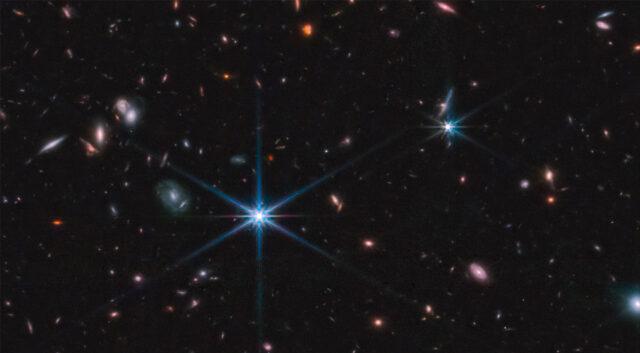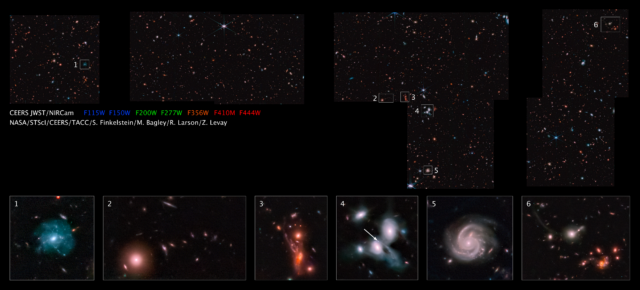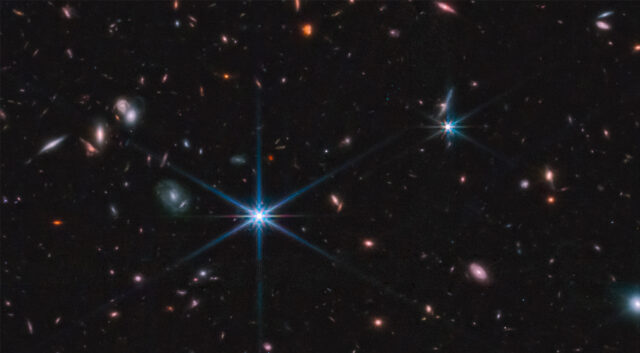[ad_1]

NASA’s James Webb Space Telescope has been making history at every opportunity since it came online earlier this year. It has surveyed distant nebulae, traced veins of dust in ancient galaxies, and peered back in time billions of years. And it’s only been operating for a few months! If the latest data release from the Cosmic Evolution Early Release Science Survey (CEERS) is any indication, Webb has only shown us a hint of what it can do. This project has just released an incredible deep space mural known as Epoch 1. The full-resolution images are hundreds of megabytes in size and contain more galaxies than you can imagine.
The CEERS Survey intends to demonstrate, test, and validate methods of extragalactic observations using three of the Webb telescope’s primary instruments: NIRCam, MIRI, and NIRSpec. The project is divided into two parts known as Epoch 1 and Epoch 2. The new data release is just the first part, which includes four of the ten planned observational blocks. These come from a tiny patch of sky near the handle of the big dipper, but there are still so, so many galaxies visible. Yes, even more than Webb’s already amazing deep field picture.
You can download the final, full-color versions of the merged images from CEERS, but be warned: They clock in at between 256 and 515 megabytes, depending on the annotations. Because they are such a high resolution, you can zoom in and just explore a sea of galaxies more than 30,000 pixels wide. The image at the top of this article is just one small fragment of Epoch 1.

Credit: NASA/STScI/CEERS/TACC/S. Finkelstein/M. Bagley/Z. Levay
In the image above, the CEERS team has identified some of the most interesting objects in Epoch 1. Here’s what makes each one notable.
- A spiral galaxy at a redshift of z = 0.16. The resolution of the JWST imaging reveals a large number of blue star-forming clumps and star clusters.
- A chance alignment of a bright galaxy at a redshift z = 1.05 with several smaller galaxies forming an arc in the sky when viewed from JWST.
- An interacting system of galaxies at z = 1.4, dubbed the “Space Kraken” by the CEERS team.
- Two interacting spiral galaxies at z = 0.7. The arrow points to a supernova discovered with these JWST images.
- Another spiral galaxy, also at z = 0.7, again highlighting JWST’s ability to resolve small-scale features even for modestly distant galaxies.
- A chance alignment of a z = 0.63 galaxy with a tidal tail, and a grouping of red galaxies at z = 1.85.
I have been waiting so long to share this, and it is finally time! Do you want to see THE BIGGEST IMAGE #JWST has taken of galaxies so far?! Our color mosaic image from @ceers_jwst is ready, and there are SO MANY GALAXIES in it! Download it here & ZOOM IN https://t.co/DJcBu8DMFl pic.twitter.com/7mhRntpXOY
— Rebecca Larson (@SaturnsWings) August 16, 2022
There’s one more important feature in Epoch 1. The team reports the discovery of a galaxy, dubbed Maisie’s galaxy, with a red shift of 11.8, meaning it could be one of the oldest galaxies ever detected. It may have formed just 280 million years after the Big Bang. If confirmed, it could provide clues about the earliest phases of star formation in the universe. And remember, this is less than half of the CEERS Survey. Time on the Webb telescope is tough to get. The CEERS team expects to conduct the next set of observations around the end of 2022.
Now read:
[ad_2]
Source link

